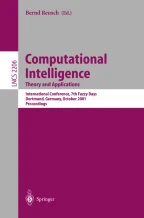Abstract
A computer vision system which can be trained to classification tasks from sample views is presented. It consists of several artificial neural networks which realize local PCA with subsequent expert nets as classifiers. The major benefit of the approach is that entirely different tasks can be solved with one and the same system without modifications or extensive parameter tuning. Therefore, the architecture is an example for the potential which lies in view based recognition: Making complicated tasks solvable with less and less expert knowledge.
Access this chapter
Tax calculation will be finalised at checkout
Purchases are for personal use only
Preview
Unable to display preview. Download preview PDF.
Similar content being viewed by others
References
S.C. Ahalt, A.K. Krisnamurthy, P. Chen, and D.E. Melton. Competitive learning algorithms for vector quantizaion. Neural Networks, 3:277–290, 1990
E. Braun, G. Heidemann, H. Ritter, and G. Sagerer. A multi-directional multiple pathe recognition scheme for complex objects. Pattern Recognition Letters, special issue on Pattern Recognition in Practice VI, Vlieland, June 99, 1999
Aristides S. Galanopoulos and Stanley C. Ahalt. Codeward distribution for frequency sensitive competitive learning with one-dimensional input data. IEEE Trans. On Neural Networks, 7(3):752–756, 1996.
Aristides S. Galanopoulos, Randolph L. Moses, and Stanley C. Ahalt. Diffusion approximation of frequency sensitive competitive learning. IEEE Trans. On Neural Networks, 8(5):1026–1030, 1997.
S. Grossberg. Competitive learning: From interactive activation to adaptive resonance. Cognitive Sci., 11:23–63, 1987.
G. Heidemann. Ein flexible einsetzbares Objecterkennungssystem auf der Basis neuronaler Netze. PhD thesis, Univ. Bielefeld, Techn. Fak., 1998. Infix, DISKI 190.
G. Heidemann, D. Lücke, and H. Ritter. A system for various visual classification tasks based on neural networks. In A. Sanfeliu et al., editor, Proc. 15th Int. Conf. on Pattern Recognition ICPR 2000, Barcelona, volume I, pages 9–12, 2000.
G. Heidemann, and H. Ritter. Combining multiple neural nets for visual feature selection and classification. In ICANN 99, Ninth International Conference on Artificial Neural Networks, pages 365–370, 1999.
G. Heidemann and H. Ritter. Visual checking of grasping positions of a three-fingered robor hand. In ICANN 2001, 2001. Accepted for publication.
G. Heidemann and H.J. Ritter. Efficient Vector Quantization using the WTA-rule with Activity Equalization. Neural Processing Letters, 13(1): 17–30, 2001.
T. Kohonen. Self-organized formation of topologically correct feature maps. Biol. Cybernetics, 43:59–69, 1982.
T. Kohonen. Self-organizationa and associative memory. In Springer Series in Information Sciences 8. Springer-Verlag Heidelberg, 1995.
T. Kohonen. Self-Organizing Maps. Springer Verglag, 1995.
T. Martinez, S.G. Berkovich, and K. Schulten. “Neural-gas” network for vector quantization and its application to time-series prediction. IEEE Transactions on Neural Networks, 4(4):558–569, 1993.
J. Moody and C. Darken. Learning with localized receptive fields. In Proc. of the 1988 Connectionist Models Summer School, pages 133–143. Morgan Kaufman Publishers, San Mateo, CA, 1988.
H. Murase and S.K. Nayar. Visual learning and recognition of 3-d objects from appearance. Int. Journal of Computer Vision, 14:5–24, 1995.
S.A. Nen, S.K. Nayar, and H. Murase. Columbia object image library: Coil-100. Technical Report CUCS-006-96, Department of Computer Science, Columbia University, 1996.
T. Poggio and S. Edelman. A network that learns to recognize three dimensional objects. Nature, pages 263–266, 1990.
H.J. Ritter, T.M. Martinez, and K.J. Schulten. Neuronale Netze. Addision-Wesley, München, 1992.
T.D. Sanger. Optimal unsupervised learning in a single-layer linear feedforward neural network. Neural Networks, 2:459–473, 1989.
Dirk Strotmann. Lokale Klassifikation als Basis für die Erkennung teilverdeckter Objecte. Master’s thesis, Universität Bielefeld, Technische Fakultät, 1999.
Michael E. Tipping and Christopher M. Bishop. Mixtures of probabilistic principal component analyzers. Neural Computation, 11(2):443–482, February 15 1999.
Author information
Authors and Affiliations
Editor information
Editors and Affiliations
Rights and permissions
Copyright information
© 2001 Springer-Verlag Berlin Heidelberg
About this paper
Cite this paper
Heidelmann, G. (2001). A Multi-purpose Visual Classification System. In: Reusch, B. (eds) Computational Intelligence. Theory and Applications. Fuzzy Days 2001. Lecture Notes in Computer Science, vol 2206. Springer, Berlin, Heidelberg. https://doi.org/10.1007/3-540-45493-4_34
Download citation
DOI: https://doi.org/10.1007/3-540-45493-4_34
Published:
Publisher Name: Springer, Berlin, Heidelberg
Print ISBN: 978-3-540-42732-2
Online ISBN: 978-3-540-45493-9
eBook Packages: Springer Book Archive
